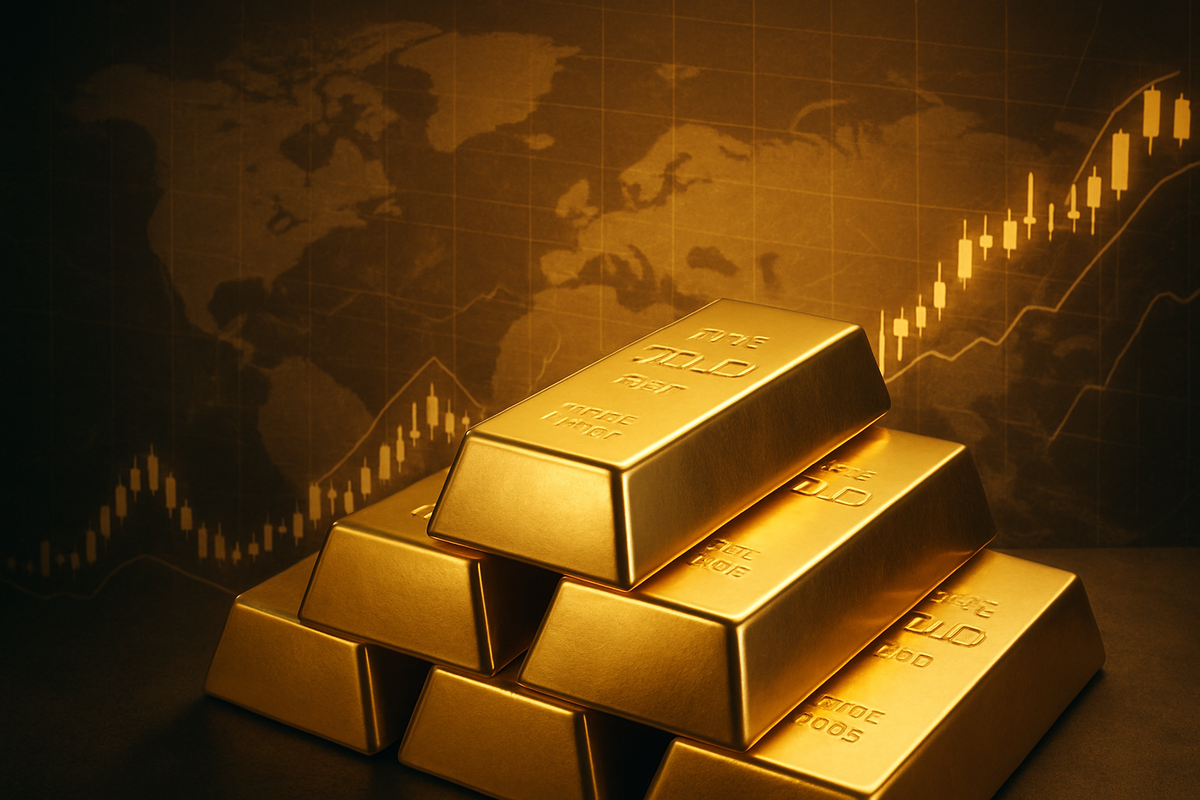
New York, NY – October 10, 2025 – Gold has ascended to unprecedented levels in early October 2025, breaching the significant $4,000 per ounce mark and reaching an all-time high of $4,059.05 on October 9. This remarkable surge, representing a gain of over 50% since the beginning of the year and a staggering 250% over the past three years, underscores gold's enduring role as a premier safe-haven asset in a world grappling with pervasive political and economic uncertainties. As global markets navigate a complex landscape of geopolitical tensions, inflationary pressures, and shifting monetary policies, investors are flocking to the precious metal, signaling a fundamental re-evaluation of its value and stability.
The rapid appreciation of gold carries immediate and profound implications for investors and the broader financial ecosystem. Its ascent provides a critical hedge against the erosion of purchasing power and offers a tangible store of value when traditional assets falter. However, it also introduces volatility, potential for short-term corrections, and necessitates a strategic recalibration of portfolio allocations. The current environment highlights a growing distrust in fiat currencies and government economic policies, pushing both institutional and retail investors towards the perceived security of gold.
The Golden Rush: Unpacking the Historic Ascent
Gold's journey to its record-breaking valuation has been fueled by a confluence of intertwined macroeconomic, geopolitical, and policy factors. The precious metal's price surge past $4,000 an ounce, culminating in the October 9 high, marks one of its most substantial rallies since the 1970s. This historic moment is not an isolated event but rather the culmination of several escalating global dynamics.
A pervasive sense of global instability, exacerbated by an ongoing U.S. government shutdown, has created widespread anxieties in financial markets. Geopolitical flashpoints, including the persistent conflicts in the Middle East between Israel and Hamas, the protracted Russia-Ukraine war, and political uncertainties in countries like France and Japan, have significantly amplified gold's safe-haven demand. Furthermore, renewed threats of "massive" tariffs on China by former President Donald Trump have reignited fears of a full-blown trade war, further escalating demand for the yellow metal.
Monetary policy shifts have also played a crucial role. Expectations of further interest rate reductions by the U.S. Federal Reserve, with two more cuts projected before the end of 2025, have reduced the attractiveness of traditional yield-bearing assets such as bonds, making non-yielding gold more appealing. Concurrently, a steady decline in the U.S. dollar, which experienced its sharpest fall in 50 years during the first half of 2025, has made dollar-denominated gold more affordable for international buyers and encouraged diversification away from the greenback.
Central banks worldwide, particularly in Asia and the Middle East, have been aggressively accumulating gold reserves to diversify their holdings and reduce their reliance on the U.S. dollar, providing a strong structural demand floor. This trend, coupled with stubbornly high inflation rates—evidenced by a 23% cumulative increase in U.S. prices between February 2020 and February 2025—has solidified gold's position as an attractive hedge against the erosion of purchasing power. The growing popularity and accessibility of gold Exchange-Traded Funds (ETFs) have also facilitated increased investor exposure, contributing to robust demand and market liquidity.
Market Movers: Companies Riding the Golden Wave and Those Facing Headwinds
The unprecedented surge in gold prices is creating a distinct divide in the corporate landscape, yielding significant beneficiaries while posing considerable challenges for others. Companies directly involved in gold extraction and related financial products are experiencing a boom, while industries reliant on gold as a raw material face increased costs and margin pressures.
The Winners: Miners and Gold-Focused Investors
Gold mining companies are the most immediate and significant beneficiaries. Their profit margins expand dramatically as production costs remain relatively stable while the value of their extracted metal soars. This translates into robust shareholder returns, increased cash flow, and enhanced opportunities for exploration and development. Leading players include:
- Newmont Corporation (NYSE: NEM, TSX: NGT): As the world's largest gold miner, Newmont benefits immensely from high gold prices, evidenced by record quarterly free cash flow and an investor-friendly capital return policy.
- Kinross Gold Corporation (NYSE: KGC, TSX: K): A low-cost producer, Kinross is seeing its profit margins explode with gold at $4,000 per ounce, with projected All-in Sustaining Costs (AISC) around US$1,500 per ounce.
- Agnico Eagle Mines Limited (NYSE: AEM, TSX: AEM): Known for its low-risk profile and ultra-low production costs, Agnico Eagle's cash flow and net income per share are expected to significantly increase.
- SSR Mining Inc. (NASDAQ: SSRM, TSX: SSRM): Identified as one of the best-performing gold stocks, benefiting directly from the rally.
- Endeavour Mining plc (LSE: EDV, TSX: EDV, OTCQX: EDVMF): A leading gold producer, particularly in West Africa, whose shares have lifted with the gold rally.
Investment vehicles and firms focused on gold also thrive. Gold-backed ETFs like SPDR Gold Trust (NYSE Arca: GLD) and iShares Gold Trust (NYSE Arca: IAU) have seen record inflows as investors seek exposure without physical storage. Gold streaming and royalty companies such as Franco-Nevada Corporation (NYSE: FNV, TSX: FNV) benefit from increased gold prices without direct mining operational costs, often offering attractive dividends. Pawnbrokers and gold buyers, like Ramsdens Holdings plc (LSE: RFX), are also experiencing increased profitability due to the higher intrinsic value of gold.
The Losers: Jewelers and Electronics Manufacturers
Conversely, industries that use gold as a primary raw material are facing significant headwinds:
- Jewelry Manufacturing and Retail: Higher gold prices directly translate to increased raw material costs, squeezing margins or necessitating higher retail prices. This can deter price-sensitive consumers, potentially reducing demand for new gold jewelry. Companies like Titan Company Ltd. (NSE: TITAN), Senco Gold Ltd. (NSE: SENCOGOLD), PC Jeweller Ltd. (BSE: PCJEWELLER, NSE: PCJEWELLER), Kalyan Jewellers India Ltd. (NSE: KALYANJWL), and P N Gadgil Jewellers Ltd. (NSE: PNGJL) are adapting by using lighter designs, offering lower karat gold options, or exploring alternative metals.
- Electronics Manufacturers: Gold is a critical component in electronics due to its conductivity. Soaring gold prices increase production costs for manufacturers like Apple Inc. (NASDAQ: AAPL), potentially impacting sales if passed on to consumers or squeezing margins if absorbed. Manufacturers are increasingly exploring alternative materials and focusing on minimizing gold content.
Investment firms holding significant short positions against gold or gold mining stocks would also incur substantial losses in this rising market.
A Wider Lens: Gold's Role in a Shifting Global Paradigm
The ascent of gold prices to record highs in October 2025 is more than just a market anomaly; it is a potent indicator of profound shifts within the global financial and geopolitical landscape. This event fits squarely into several broader industry trends, reflecting deep-seated anxieties and a recalibration of investment strategies.
Firstly, gold's rally underscores its reinforced status as the ultimate inflation hedge. With stubbornly high inflation persisting across major economies, investors are increasingly turning to gold to protect their purchasing power against currency debasement. This trend is further amplified by a weakening U.S. dollar, making dollar-denominated gold more attractive to international buyers and signaling a broader move away from dollar dependency. The current environment draws strong parallels to the inflationary 1970s, when gold prices soared by approximately 1,500%, and the 2008-2011 period of quantitative easing. However, the current surge is unique, as gold's inflation-adjusted value now surpasses previous historical peaks, indicating a deeper, structural reassessment.
Secondly, the unprecedented demand from central banks is a critical trend. Central banks globally, particularly in Asia and the Middle East, have been on an aggressive gold-buying spree, acquiring over 3,200 tonnes between 2022 and 2024, a trend that continues robustly into 2025. This strategic diversification away from the U.S. dollar has significant regulatory and policy implications, signaling a deliberate effort to reduce reliance on any single reserve currency and enhance financial security. For the first time since 1996, central banks now collectively hold more gold than U.S. Treasuries, representing a monumental shift in international monetary policy and reserve management strategies.
Thirdly, the geopolitical backdrop is undeniable. Ongoing conflicts, political instability in major economies, and renewed threats of trade wars are creating a pervasive sense of uncertainty. This environment pushes investors away from riskier assets and towards the perceived safety and liquidity of gold, outperforming even other traditional safe havens like the Japanese Yen, which has recently dropped due to its own political uncertainties. The U.S. government shutdown, for instance, has been explicitly cited as a factor amplifying market uncertainty and driving gold demand, highlighting how domestic fiscal policy dysfunction can have global ripple effects on asset prices.
The ripple effects extend beyond direct market participants. While gold miners enjoy expanded profit margins, the jewelry industry faces reduced consumer demand and is adapting through design changes and increased recycling. The electronics sector also grapples with higher input costs. The significant rise in gold prices could also spur increased interest in other precious metals and potentially influence currency markets as nations reassess their reserve allocations. This record rally is not just about gold; it's a barometer of global economic health and geopolitical stability, signaling a profound shift in how investors and nations perceive value and security in an increasingly uncertain world.
The Road Ahead: Navigating Gold's Future Trajectory
As gold prices sit at historic highs in October 2025, market participants are keenly looking ahead to discern the precious metal's future trajectory. While short-term volatility is anticipated, the overarching sentiment points towards a continued bullish outlook for gold, underpinned by persistent structural drivers.
In the short term (remainder of 2025 to early 2026), most analysts expect gold to maintain its elevated levels, with some projecting further ascent. However, the rapid climb has led to warnings of potential short-term price corrections, perhaps 10-15%, which could offer new entry points for investors. Forecasts for late 2025 to early 2026 range from $4,200 to $5,000 per ounce, with institutions like UBS Global Wealth Management and Goldman Sachs revising their targets upwards. Continued Federal Reserve rate cuts, sustained central bank buying, ongoing geopolitical instability, and persistent inflation are expected to be the primary catalysts. Global gold mine production, which has largely plateaued, is expected to offer minimal growth, further constraining supply in the face of rising demand.
The long-term outlook (2026-2030 and beyond) remains overwhelmingly optimistic. Many experts believe gold is in the nascent stages of a multi-year bull market. Long-term forecasts generally show strong consensus for continued gains, with projections reaching $4,500-$5,000 by 2027-2028, and some aggressive forecasts even suggesting $7,000 or $10,000 by 2030 under extreme scenarios of runaway inflation or severe geopolitical crises. This long-term growth will be underpinned by continued robust central bank demand for diversification away from the U.S. dollar, sustained investor holdings, and gold's enduring role as a safe-haven asset amidst ongoing global uncertainties.
Strategic adaptations will be crucial for market participants. Investors are advised to maintain a diversified portfolio, with gold forming a strategic, rather than speculative, component. Access to gold can be achieved through various avenues, including physical bullion, digital gold, and highly liquid ETFs. Miners, meanwhile, are in an optimal position, with high gold prices creating strong cash flows and making previously uneconomical projects viable. However, they must also contend with rising production costs and regulatory hurdles. Jewelers and electronics manufacturers will need to continue innovating with designs, materials, and cost-efficiency measures to mitigate the impact of high gold prices. Emerging markets present both opportunities, with projected demand growth and central bank diversification, and challenges, including political instability and environmental concerns.
Potential scenarios range from a continued bullish ascent as the base case, driven by current fundamentals, to a short-term correction followed by a renewed rally. A period of sustained consolidation around current high levels is also possible. While factors like a stronger dollar or rapid interest rate hikes could moderate gains, the current structural drivers appear robust for the foreseeable future.
Golden Horizon: A Summary and Forward Look
Gold's recent surge to record highs, exceeding $4,000 per ounce in early October 2025, unequivocally reaffirms its status as a vital safe-haven asset in a volatile global economy. This historic rally is not merely a fleeting market phenomenon but a profound reflection of deep-seated anxieties regarding geopolitical stability, persistent inflation, and the integrity of traditional financial systems. The confluence of a weakening U.S. dollar, anticipated Federal Reserve rate cuts, unprecedented central bank buying, and widespread global uncertainty has created a powerful tailwind for the precious metal.
Moving forward, gold is poised to remain an essential component of diversified investment portfolios. While the rapid ascent may invite short-term corrections, the underlying structural drivers suggest a continued bullish trajectory in the medium to long term. Miners are set to benefit significantly from expanded profit margins, while industries reliant on gold as a raw material will need to continue adapting their strategies to manage increased costs. The shift in central bank reserve management, with gold now surpassing U.S. Treasury holdings, signals a fundamental recalibration of global financial architecture.
Investors should closely monitor key indicators in the coming months: the pace and extent of Federal Reserve monetary policy adjustments, ongoing geopolitical developments, global inflation data, and the continued buying patterns of central banks. Gold's ability to act as a hedge against systemic risk and currency debasement will likely keep it in the spotlight, making it a critical asset for those seeking stability and capital preservation in an unpredictable world. Its current record-breaking performance is a powerful testament to its enduring appeal and its pivotal role in the evolving financial landscape.
This content is intended for informational purposes only and is not financial advice





